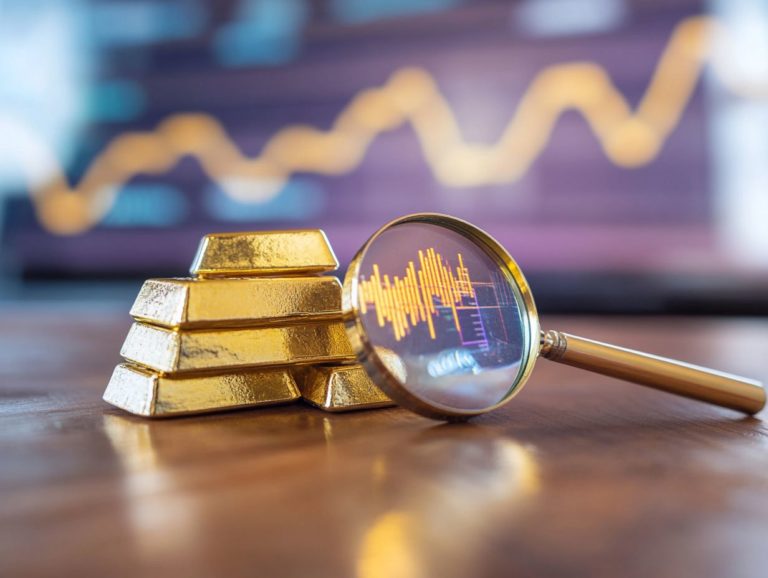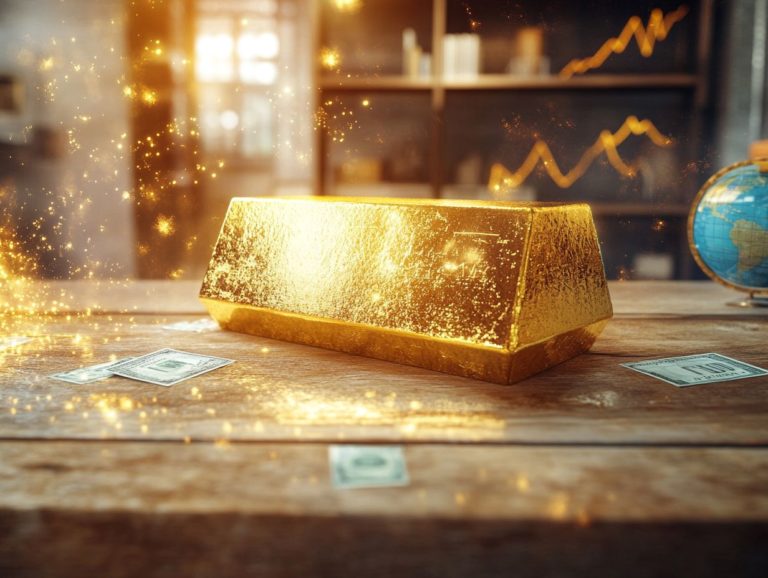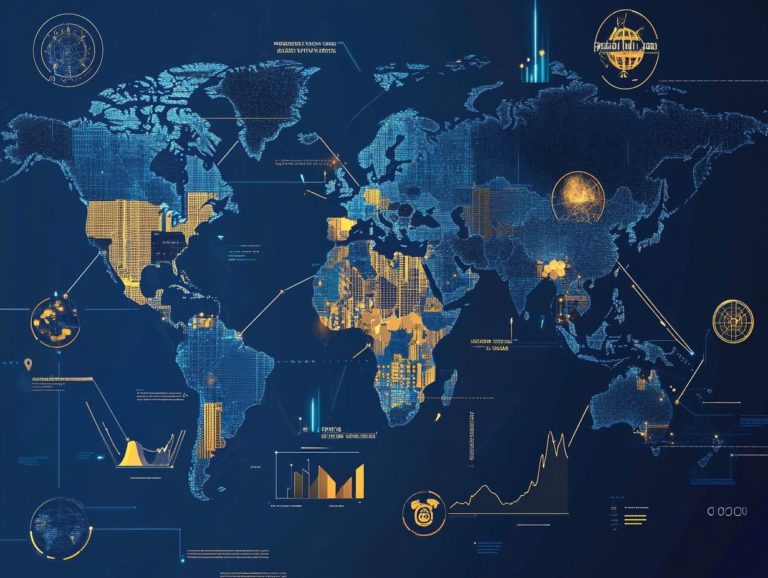5 Critical Factors Affecting Platinum Prices
Platinum, renowned as a precious metal with remarkable traits, captivates both investors and various industries alike.
Understanding its price fluctuations is crucial for seasoned investors and those curious about the market.
This article delves into five key factors that profoundly influence platinum prices:
- The dynamics of supply and demand.
- Prevailing economic conditions.
- Political stability.
- Industrial usage.
- Investment demand.
Explore how these elements interconnect and what potential future trends may reveal. Dive in to uncover the complexities of the platinum market, empowering you to make informed decisions.
Contents
- Key Takeaways:
- 1. Supply and Demand
- 2. Economic Conditions
- 3. Political Stability
- 4. Industrial Demand
- 5. Investment Demand
- What Is the Current State of the Platinum Market?
- How Do Changes in Supply and Demand Affect Platinum Prices?
- What Role Do Economic Conditions Play in Platinum Prices?
- How Does Political Stability Impact Platinum Prices?
- What Are the Main Industries That Use Platinum and How Does This Affect Prices?
- Why Do Investors Choose Platinum and How Does This Affect Prices?
- What Are Some Other Factors That Can Affect Platinum Prices?
- How Can Investors Stay Informed about Platinum Prices?
- What Are Some Predictions for the Future of Platinum Prices?
- How Can One Invest in Platinum?
- What Are the Risks and Benefits of Investing in Platinum?
- How Can One Determine the Right Time to Buy or Sell Platinum?
- What Are Some Common Misconceptions About Platinum Prices?
- Frequently Asked Questions
- What are the 5 critical factors that affect platinum prices?
- How does supply and demand influence platinum prices?
- What economic conditions impact platinum prices?
- Can geopolitical events affect platinum prices?
- How does investment demand impact platinum prices?
- What role does industrial demand play in platinum prices?
Key Takeaways:
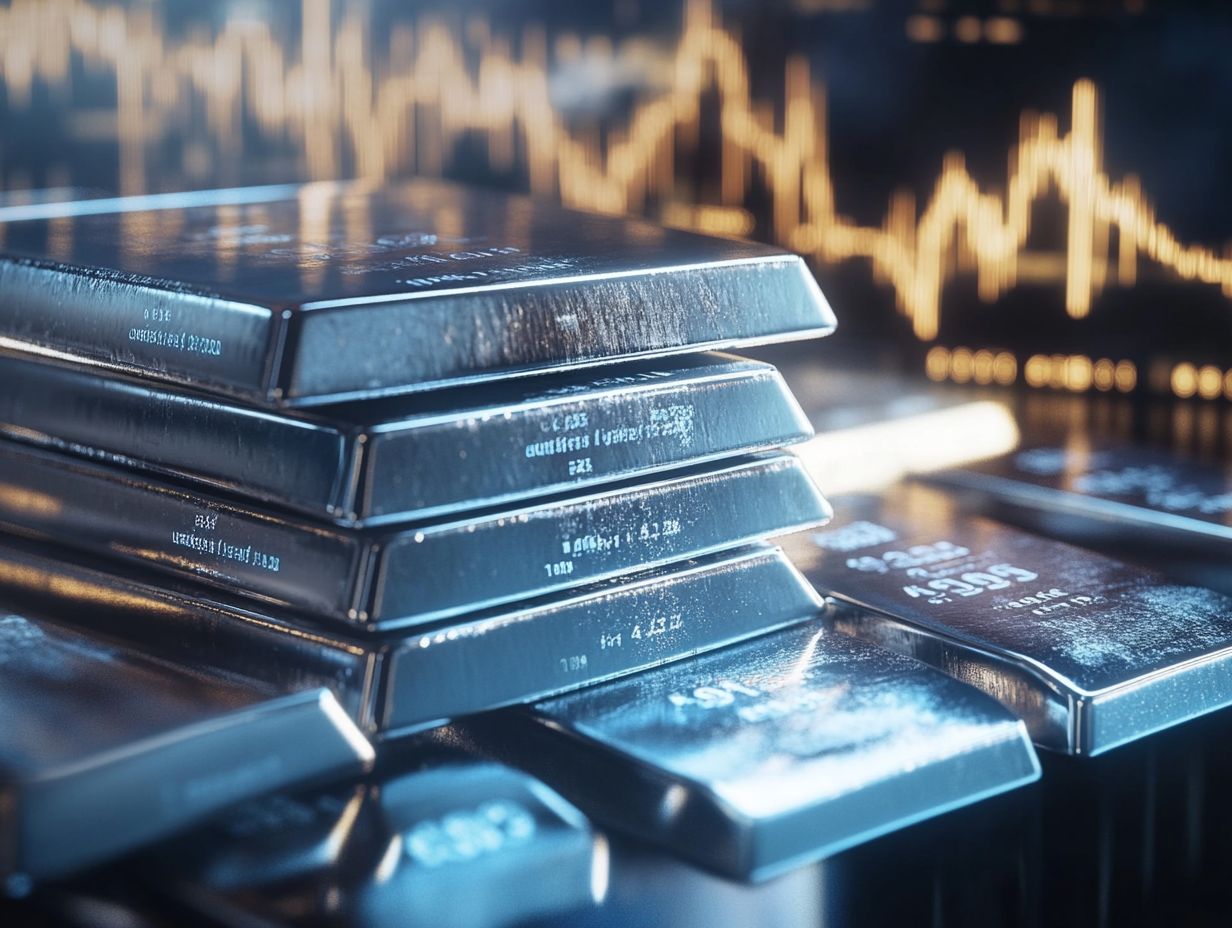
Supply and demand greatly impact platinum prices. Changes in production and demand can lead to market fluctuations.
Economic conditions, such as inflation and interest rates, also affect platinum prices, influencing demand and investment decisions.
Political stability is crucial in the platinum market. Political unrest can disrupt supply and demand, causing price changes.
1. Supply and Demand
The dynamics of supply and demand are pivotal in shaping the value of platinum. Prices are influenced by factors like mining production rates, political issues, and technological advancements. Understanding these factors provides insight into complex market dynamics and investment opportunities, particularly in key regions like South Africa and Russia.
When the supply of platinum exceeds demand, prices tend to fall. For instance, an increase in mining production can lead to price drops, often seen during years of strong output from major mines.
Conversely, political tensions, such as labor strikes in South Africa or sanctions affecting Russia, can disrupt supply chains, driving prices upward due to limited availability.
Technological advancements in the automotive sector, especially with the rise of electric vehicles, can reduce platinum’s demand for catalytic converters. At the same time, they explore its potential in battery technology, adding further complexity to price fluctuations.
2. Economic Conditions
Economic conditions significantly impact platinum prices. Shifts in global economic health, inflation trends, and central bank policies directly influence investment sentiment and demand for this precious metal.
When GDP growth is strong, optimistic investors are more likely to invest in assets like platinum, viewing it as a safeguard against inflation. However, during economic slowdowns, inflationary pressures can increase volatility, prompting you to reassess your portfolio strategy.
Central banks play a crucial role; by adjusting interest rates and implementing quantitative easing, they affect market liquidity. Increased liquidity often spurs investment activity, but unpredictable conditions can lead to significant fluctuations in platinum prices, shaping investor behavior in intricate ways.
3. Political Stability
Political stability in key mining countries like South Africa and Russia shapes your investment outlook and influences platinum prices. Geopolitical events can disrupt supply chains and spark market speculation, creating an environment of uncertainty.
For example, recent unrest in South Africa due to labor strikes has raised concerns about the continuity of mining operations, resulting in volatility within platinum markets. Tensions from sanctions imposed on Russia further exacerbate the situation, limiting access to critical resources and driving prices higher in anticipation of shortages.
These circumstances highlight the fragile balance of supply, where investor confidence may waver with the political landscape. As political challenges arise, the potential for fluctuating platinum prices increases, compelling you to stay vigilant regarding these geopolitical currents.
Stay informed to seize the best investment opportunities!
4. Industrial Demand
Industrial demand for platinum is significant, especially in the automotive sector. It is crucial for catalytic converters, which reduce harmful emissions from vehicles.
This demand is driven by technological advancements and evolving manufacturing processes. As automotive manufacturers focus on improving fuel efficiency, the need for platinum in vehicles continues to rise.
Global regulations aimed at reducing pollution compel the industry to adopt more effective catalytic systems. These systems rely on platinum’s unique properties.
Innovations like electric vehicles still require platinum for certain battery technologies and hydrogen fuel cells. This shifting demand illustrates how industrial practices and the push for cleaner technologies can significantly affect platinum prices.
5. Investment Demand
Investment demand for platinum is rising. Many are diversifying their portfolio by exploring various investment options like platinum ETFs and physical platinum.
This increase is linked to factors shaping risk tolerance. People are becoming more cautious about market volatility and inflationary pressures.
As a result, platinum is seen not only as a precious metal like gold, but also as a viable choice for wealth preservation.
While traditional methods like purchasing physical bars or coins remain popular, innovative products like futures contracts which are agreements to buy or sell an asset at a future date and exchange-traded funds provide enhanced liquidity and accessibility.
These options allow you to customize your exposure to platinum. This way, you can align your investment strategies with the current economic climate while hedging against potential downturns.
What Is the Current State of the Platinum Market?
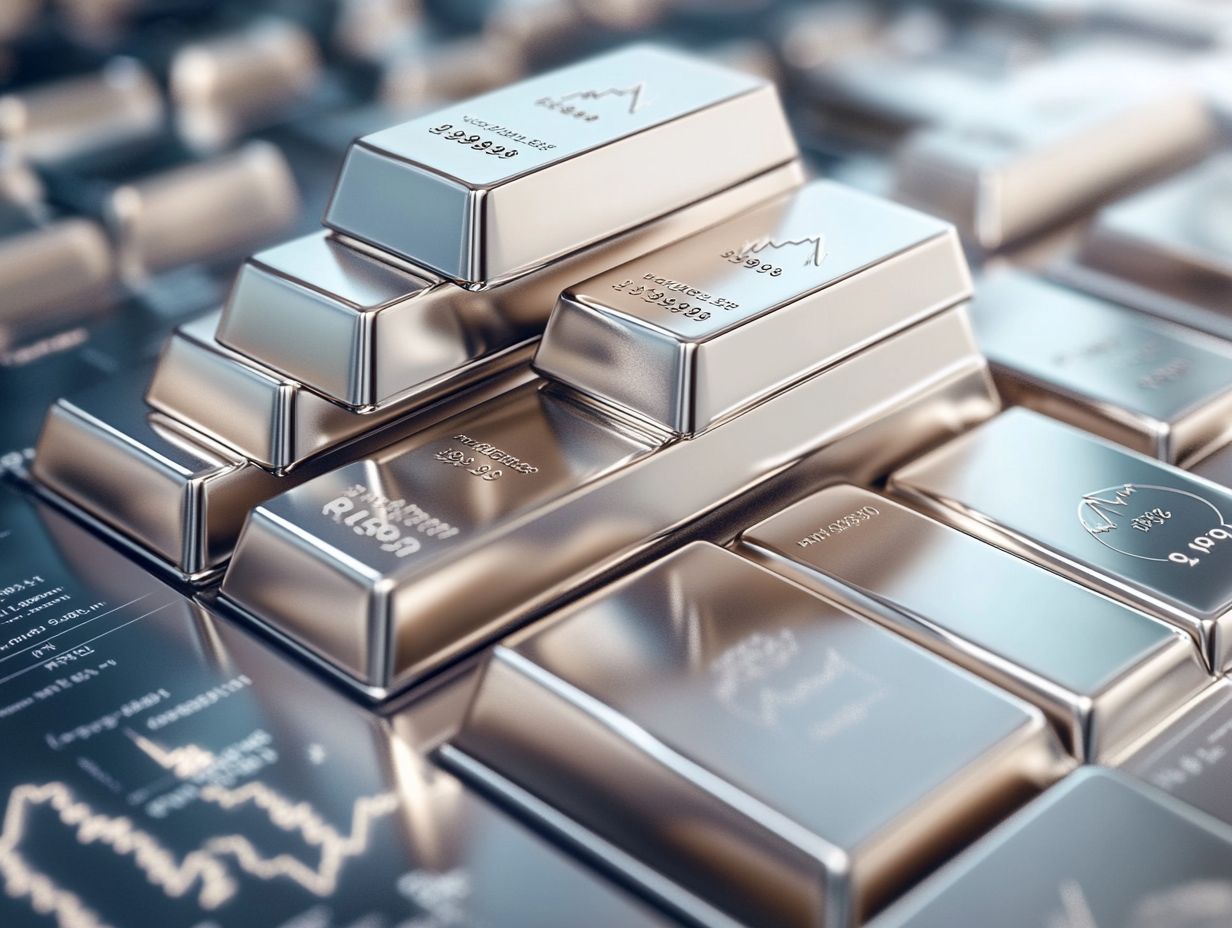
The platinum market is buzzing with activity due to various factors that affect prices and investment opportunities. These include market trends, economic forecasts, and evolving demand dynamics.
Recently, you may have noticed significant price volatility, largely driven by geopolitical tensions and fluctuating industrial demand. Experts suggest that tightening monetary policies from central banks worldwide could further sway market sentiment.
Reports from leading industry analysts indicate that changes in automotive manufacturing especially the rise of electric vehicles are altering consumption patterns. Keep a close eye on these developments, along with key economic indicators like inflation rates and employment data, as they can provide clearer insights into future price trends.
How Do Changes in Supply and Demand Affect Platinum Prices?
Changes in supply and demand directly impact platinum prices. Shifts in mining production and industrial demand can lead to significant price movements, often influenced by market speculation and the broader economic landscape.
Take the 2008 financial crisis as an example. Demand for platinum, vital for automotive catalytic converters, plummeted sharply, causing prices to drop steeply.
Conversely, in 2011, when demand surged due to increased production in emerging markets and tighter supplies from key mining countries, platinum prices skyrocketed to record highs.
These instances show how fluctuations in supply ranging from labor strikes in South Africa to geopolitical tensions affecting mining operations combined with demand spikes from various industrial sectors, can create a volatile environment in the platinum market.
What Role Do Economic Conditions Play in Platinum Prices?
Economic conditions play a huge role in platinum prices. Factors like inflation, central bank policies, and market trends can quickly shift investor sentiment.
For instance, when inflation rates rise, they can erode purchasing power. This leads people to seek refuge in tangible assets like platinum.
Central bank actions, including interest rate changes, directly affect borrowing costs and consumer spending. These create ripple effects throughout the economy.
These factors are closely connected. If inflation escalates, central banks might tighten monetary policy, potentially stifling growth and dampening industrial demand for platinum.
Platinum is used in various sectors, including automotive and jewelry. Fluctuations in these economic indicators can greatly impact platinum prices.
How Does Political Stability Impact Platinum Prices?
Political stability is crucial in determining platinum prices. Geopolitical events can disrupt mining production and shift investor sentiment, leading to market volatility.
Consider the labor strikes in South Africa, a major platinum producer, in 2014. These disruptions significantly reduced output, causing a sharp price increase due to fears of shortages.
Political turmoil in Zimbabwe, another key mining nation, has also hampered production. Traders react swiftly to potential supply deficits, showing the ties between geopolitics and market fluctuations.
What Are the Main Industries That Use Platinum and How Does This Affect Prices?
The primary industries using platinum, notably automotive and manufacturing, shape its prices significantly. When industrial demand shifts due to technological advancements, market fluctuations often follow.
The trend toward electric vehicles has sparked interest in alternative materials, which may lessen the demand for platinum in catalytic converters. Meanwhile, sectors like electronics and jewelry maintain a strong reliance on this precious metal.
As renewable energy technologies like fuel cells advance, they add complexity by potentially increasing platinum’s demand in energy storage solutions.
These trends drive immediate pricing fluctuations and could redefine the long-term value proposition across various sectors.
Why Do Investors Choose Platinum and How Does This Affect Prices?
Investors opt for platinum for various compelling reasons! Its role as a strategic asset helps diversify portfolios, while its historical performance as a safe-haven investment significantly influences market pricing trends.
Platinum’s intrinsic value, stemming from its rarity and essential industrial applications, becomes especially attractive in times of economic uncertainty. Investors often turn to this precious metal when inflation rises or geopolitical tensions loom.
The relationship between supply constraints often due to mining challenges and consistent demand from industries like automotive and electronics creates a vibrant market dynamic. As investment trends evolve, the demand for platinum continues to influence its valuation, attracting discerning investors seeking long-term growth.
What Are Some Other Factors That Can Affect Platinum Prices?
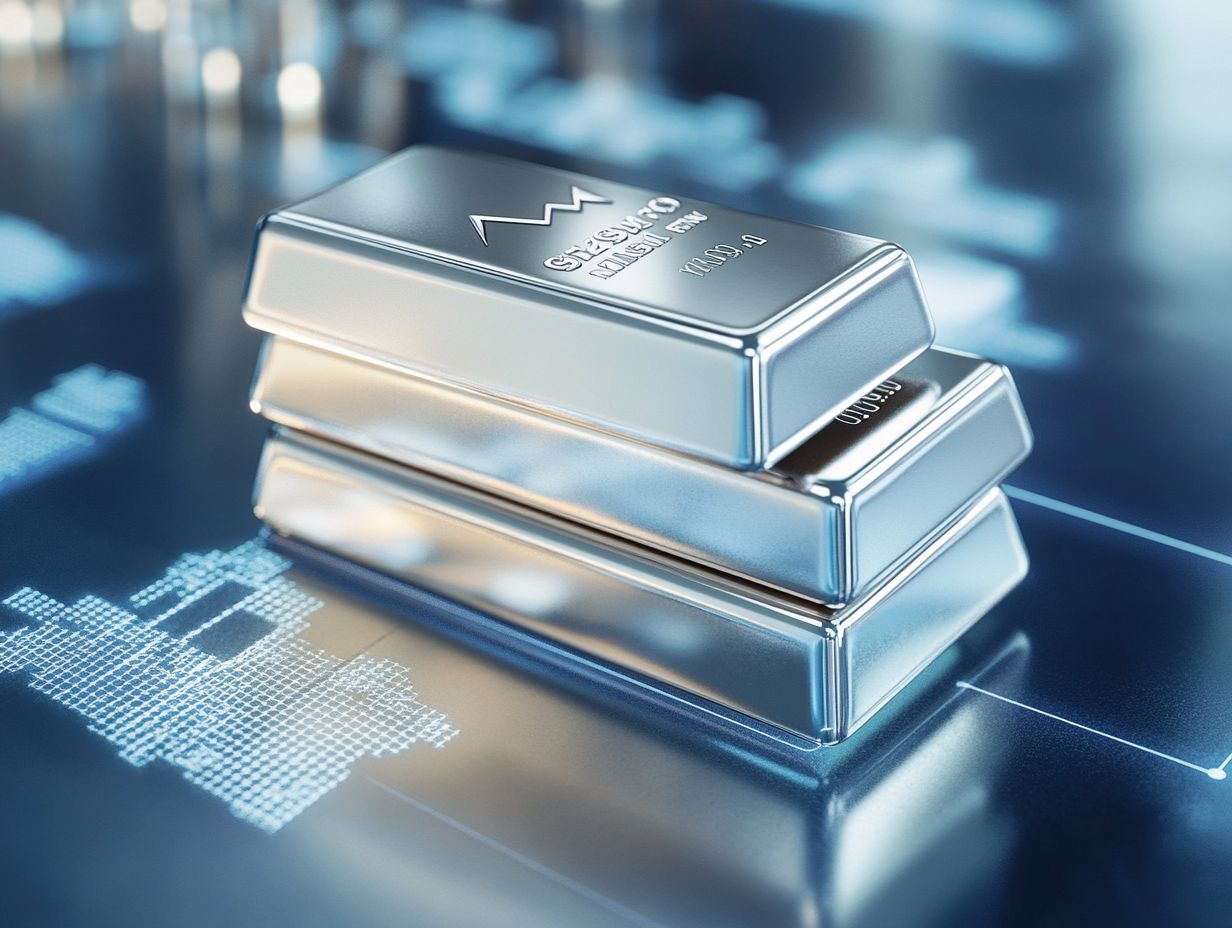
Beyond the simple dance of supply and demand, several other factors play a significant role in shaping platinum prices. Economic indicators, market volatility, supply chain disruptions, and shifts in consumer behavior can all lead to unexpected price movements.
As an investor, you may find yourself responding to economic reports like GDP growth or employment rates. These insights can ripple through market sentiment, influencing your trading decisions.
Geopolitical tensions add another layer of uncertainty. They impact the supply chain and ultimately affect prices.
Changes in regulations or technological advancements in industries that rely on platinum, like automotive or electronics, contribute to fluctuating demand. Consumer preferences are evolving, especially as sustainable alternatives gain traction. This interplay of factors creates a complex web that intricately shapes platinum’s market trends.
How Can Investors Stay Informed about Platinum Prices?
You can stay informed about platinum prices by tapping into a variety of resources, including trading platforms, industry reports, and financial news that illuminate market trends and economic indicators.
In today’s dynamic financial landscape, using technology is essential for effective monitoring. Tools like mobile trading apps, which deliver real-time price updates, give you the ability to respond swiftly to market fluctuations.
Subscribing to specialized news outlets that focus on precious metals or utilizing market analysis platforms can deepen your understanding and provide valuable context around price movements.
By taking a proactive approach to staying informed, you not only enhance your ability to make educated investment decisions but also sharpen your skills in recognizing patterns and emerging opportunities, ultimately leading to more strategic portfolio management.
What Are Some Predictions for the Future of Platinum Prices?
Predictions for the future of platinum prices hinge on a variety of factors, including economic forecasts and market trends, offering thrilling challenges and investment opportunities for you as a savvy investor.
Keep a close eye on shifts in industrial demand, especially from the automotive sector, where platinum plays a crucial role in catalytic converters. Geopolitical influences and fluctuations in how much platinum is mined are also critical variables shaping the landscape.
For instance, if mining disruptions occur in major producing countries, you might see prices surge unexpectedly. Stay aware of these elements to position yourself advantageously. This kind of insight aids in strategizing potential buys and sells while clarifying the risk-reward balance, giving you the power to make smarter, more informed decisions in this volatile market.
How Can One Invest in Platinum?
Investing in platinum can be an exciting opportunity, whether through an investment account, purchasing physical platinum, or diving into platinum ETFs. Each of these avenues comes with its own unique benefits and considerations.
Understanding these options is essential if you’re looking to diversify your portfolio. Physical platinum, often found in the form of bars or coins, offers you tangible ownership and serves as a robust hedge against inflation. However, it requires secure storage and insurance, which can add to your overall costs.
On the flip side, platinum ETFs provide a more convenient way for you to gain exposure to platinum without the complexities of physical ownership. An ETF is a type of fund that trades like a stock and tracks the price of platinum. While they offer liquidity and generally lower transaction costs, it s important to consider management fees and the potential for less direct control over your asset.
Ultimately, your decision between physical platinum and ETFs hinges on your individual risk tolerance, liquidity needs, and investment goals.
What Are the Risks and Benefits of Investing in Platinum?
Investing in platinum presents a mix of risks and benefits that you must navigate. You’ll weigh potential market volatility against opportunities for diversification and protection against inflation.
In the commodities market, platinum is valued for its distinctive properties, but it comes with complexities. Consider the unpredictable nature of its market, where prices can swing dramatically due to factors like demand from the automotive sector and mining production changes.
Liquidity challenges may arise, making it harder to buy or sell quickly without affecting prices. This precious metal is more than a speculative venture; its reputation as a safe-haven asset attracts investors during economic uncertainty. With potential for significant price appreciation over time, many see it as a valuable addition to their portfolios.
How Can One Determine the Right Time to Buy or Sell Platinum?
To find the best moment to buy or sell platinum, analyze market trends, economic indicators, and your unique investment strategies.
You might use various techniques to improve your decision-making in this volatile market. One effective method is technical analysis, a method to study past price movements to predict future prices.
Understanding market cycles helps you recognize when platinum is likely to appreciate or depreciate. Stay informed about key economic indicators, such as interest rates and inflation figures, to refine your investment choices and identify advantageous entry or exit points in the platinum market.
What Are Some Common Misconceptions About Platinum Prices?
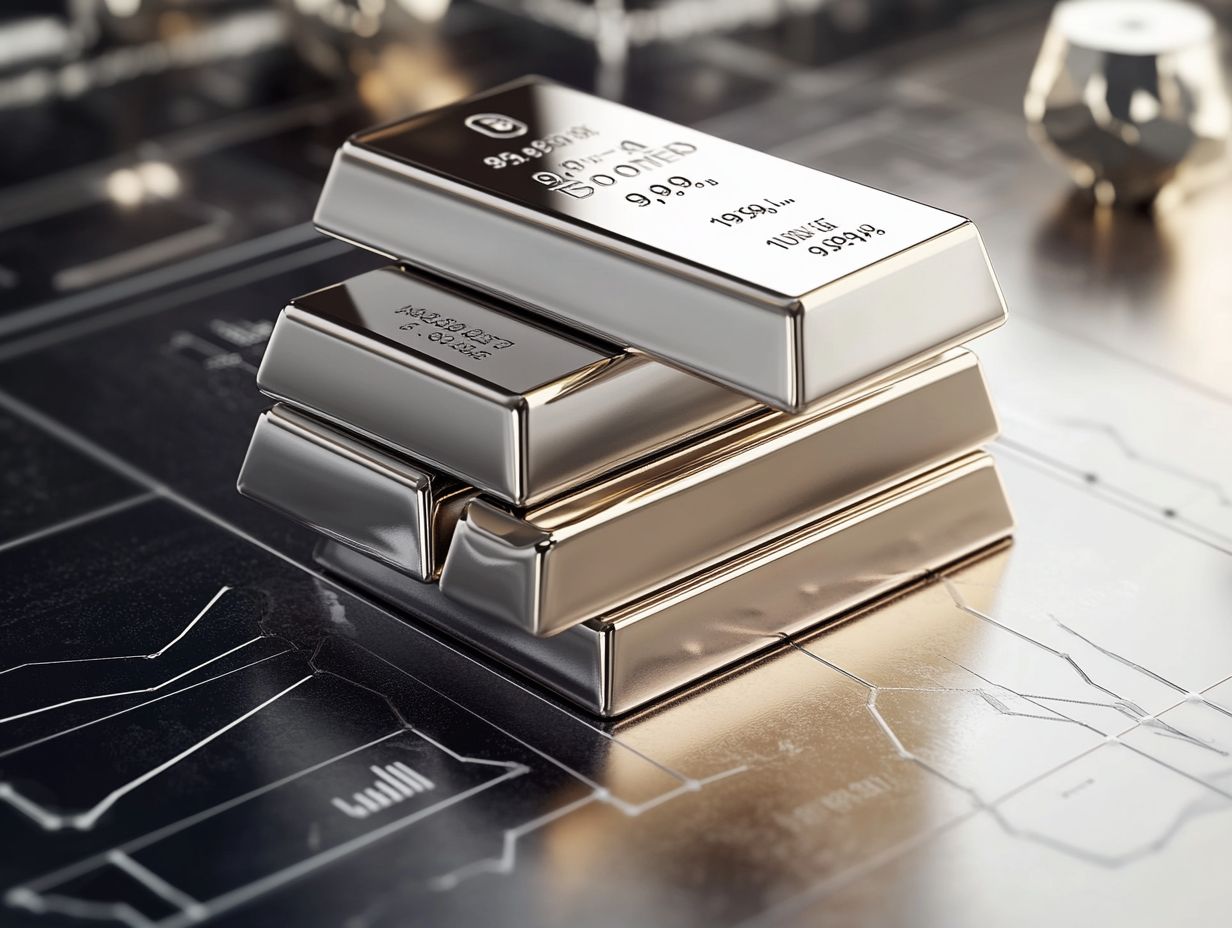
Common misconceptions about platinum prices can mislead your investment strategies, especially if you’re unaware of market dynamics and the external factors affecting price fluctuations.
You might think platinum is always more valuable than gold, but this oversimplification misses the complexities of supply and demand, industrial applications, and geopolitical influences that significantly affect pricing. Misunderstandings about the rarity of platinum compared to other precious metals can distort your perceptions.
By addressing these misconceptions, you can gain a clearer perspective on market trends. This empowers you to make informed decisions based on real data rather than assumptions.
Grasping investor sentiment and the global economic landscape is essential for navigating this intricate marketplace.
Frequently Asked Questions
What are the 5 critical factors that affect platinum prices?
The 5 critical factors that affect platinum prices are supply and demand, economic conditions, geopolitical events, investment demand, and industrial demand.
How does supply and demand influence platinum prices?
Like any commodity, platinum prices depend on the balance between supply and demand. If supply exceeds demand, prices will decrease, and vice versa.
What economic conditions impact platinum prices?
Economic conditions such as inflation, interest rates, and global economic growth significantly impact platinum prices. For example, rising interest rates may drive investors to other assets, causing platinum prices to fall.
Can geopolitical events affect platinum prices?
Yes, geopolitical events like political instability, trade disputes, and natural disasters can influence platinum prices. Such events create market uncertainty, prompting investors to seek safe-haven assets like platinum.
How does investment demand impact platinum prices?
Investment demand for platinum, especially through ETFs (Exchange-Traded Funds), can significantly influence prices. High investment demand typically leads to price increases as more investors buy platinum.
What role does industrial demand play in platinum prices?
Industrial demand is a key factor in platinum prices.
Its unique properties make platinum ideal for various industrial uses, including catalytic converters. This widespread use drives up demand and influences prices.











